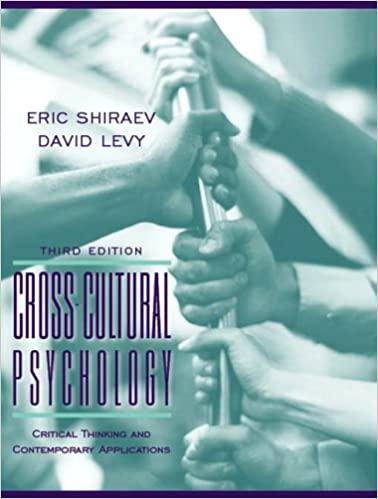Question
Many people with disabilities are successfully employed. However, discrimination in hiring people with disabilities is still a problem in the US. This is despite the
Many people with disabilities are successfully employed.
However, discrimination in hiring people with disabilities is still a problem in the US. This is despite the Americans with Disabilities Act of 1990, which makes this illegal. This means there are a lot of great workers out there who can't find jobs and many employers who are missing out on qualified talent that can help them in today's economy. A recent survey of 463 hiring managers found that over half agreed that their organizations discriminated against people with disabilities. The study also found that misinformation on the part of hiring managers was the reason for such discrimination. Therefore, the goal of this video is to dispel common myths about workers with disabilities. A disability is a physical or mental impairment that limits one or more major life activities. Examples include having difficulty hearing or seeing or having a disabling chronic health condition.
Many disabilities are non-apparent and may include mental health conditions like major depression and anxiety disorders. Almost one in five people in the working age population has a disability. Yet, according to the US Bureau of Labor Statistics, in 2017, only 19% of individuals with disabilities were employed, compared to 66% of people without disabilities.
- Across all ages and levels of education, people with disabilities have much higher rates of unemployment than non-disabled people. This means a much higher percentage of people with disabilities want to work but can't find work when compared to the percent of people without disabilities.
There are many myths out there about disabilities in the workplace that may deter employers from hiring people with disabilities. We now present three myths and realities relating to disabilities and work. One myth is that workers with disabilities can't perform their jobs as well as workers without disabilities. This is simply not true. This myth is perhaps the most harmful to workers with disabilities, as it leads people to falsely conclude that people with disabilities should automatically be discounted or discredited from hiring consideration. Yet, there are many qualified people with disabilities who have the talent, skills, and ability to perform if given the the opportunity. One reason the first myth exists is because hiring managers may not seek the appropriate information needed to make a valid assessment about the qualifications of individuals with disabilities.
This leads us to a second myth, which is that hiring managers are not allowed to ask employees questions about whether they can perform job functions during the hiring process. Again, this is simply not true. To be considered a qualified applicant for a position, the US Equal Employment Opportunity Commission states that a disabled worker must be able to perform essential job functions with or without a reasonable accommodation. What does this mean? It means that people with disabilities must be able to perform the core tasks that are critical to the role in which they are hired. Just as a hiring manager can ask a person without a disability about their qualifications and ability to perform core tasks needed for the job, they're also able to ask people with disabilities about their qualifications and abilities relevant for performing job tasks.
The third myth we want to discuss is about job accommodations. Unfortunately, many employers fear that accommodations will be excessively costly or difficult to implement. Again, this is not true. A reasonable accommodation is a change to the work environment, equipment, or the way work is done for a person with a disability. Reasonable accommodations can be used both during the hiring process and when someone is employed on the job. Some examples of reasonable accommodations are providing specialized software for a worker with a visual impairment and allowing a worker with disability-related fatigue to use a stool rather than stand. Cost and implementation vary by accommodation. But employers may be surprised to find out that many accommodations are inexpensive and easy to provide. A recent study from the US Department of Labor of almost 1,200 US employers across a wide range of industry sectors and sizes reported several important points. First, over half of accommodations cost nothing, while the rest cost, on average, $500. Second, tax credits and deductions are available for organizations implementing reasonable accommodations. Importantly, most of these were one-time costs. Only 4% of accommodations incurred ongoing costs. Finally, and most importantly, employers reported benefiting far more from accommodations given than they cost to implement.
How do they benefit? They were able to retain valued employees and improve worker productivity. Sounds like a win-win.
Assume that the text above was provided as training to all employees and supervisors in an organization, and your job is to make recommendations about how to go about evaluating this training
Answer the following questions:
- Summary: Please provide a brief summary of this training. Broadly, state the goals and summarize the content of the training.
- Reactions: How would you measure reactions to this training (reaction criteria)? Provide an example.
- Learning: How would you measure learning stemming from this training (learning criteria)? Be specific and provide an example.
- Behavior: How would you measure whether employee behavior was changed as a result of this training (behavioral criteria)? Be specific. Hint: think about this as if supervisors in the organization would go through this training.
- Results: What would you look for in terms of results of this training (results criteria)? How would you measure this?
Step by Step Solution
There are 3 Steps involved in it
Step: 1

Get Instant Access to Expert-Tailored Solutions
See step-by-step solutions with expert insights and AI powered tools for academic success
Step: 2

Step: 3

Ace Your Homework with AI
Get the answers you need in no time with our AI-driven, step-by-step assistance
Get Started


